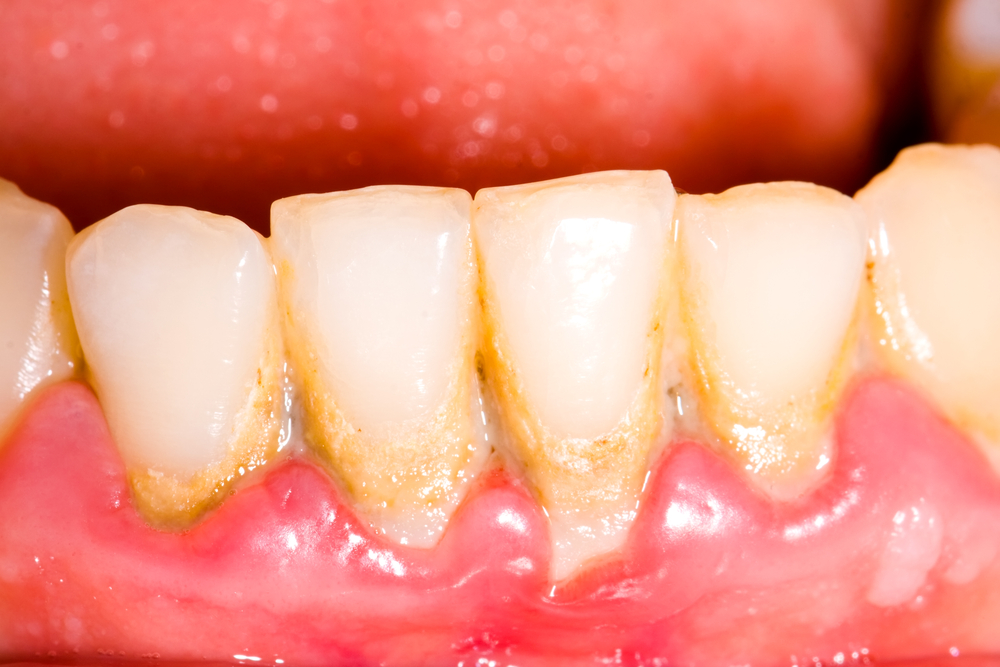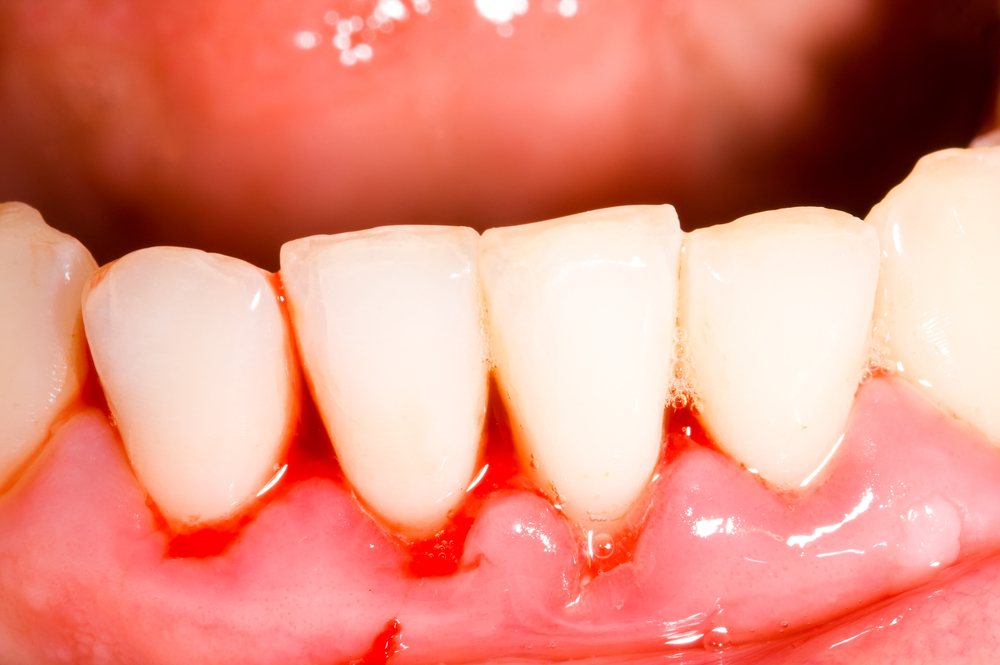Gingivitis & Periodontitis: Symptoms & Treatment of Gum Disease

There are two types of diseases that can affect the gums: gingivitis and periodontitis. Together, gingivitis and periodontitis are referred to as gum disease or periodontal disease.
The National Institute of Health defines periodontal (gum) disease as “inflammation and infection that destroys the tissues that support the teeth, including the gums, the periodontal ligaments, and the tooth sockets (alveolar bone).”
Both types of gum diseases are fairly common among adults in the United States and both can be stopped or their symptoms lessened with effective care.
Gingivitis
Gingivitis is a mild form of gum disease, but without proper treatment it can lead to the more serious periodontitis, according to the Mayo Clinic. It is characterized by red and irritated gums.
Gingivitis is quite common, with many people having it to different strengths. Dr. Margaret Culotta-Norton, a dentist in Washington, D.C., and former president of the D.C. Dental Society, reported that about 50 percent of the population experiences gingivitis on four or more teeth. “Those at increased risk include anyone with poor dental hygiene, minorities, those who are less educated, smokers, uncontrolled diabetics, older adults, pregnant women, those with decreased immunity, those with poor nutrition, substance abusers and those who do not seek the services of a dental professional often.”
According to the Mayo Clinic, gingivitis is primarily caused by poor oral hygiene, which allows plaque to build up on teeth. Plaque is an invisible, sticky substance that develops on the teeth when sugars and starches in food interact with normal mouth bacteria. It develops quickly, which is why it is important to brush and floss every day to remove it.
The National Institutes of Health warned that if it is not removed, plaque can turn into tartar, a hard deposit at the base of the tooth. Both plaque and tartar inflame gums and produce bacteria and toxins that cause gums to get infected with gingivitis.
Get the world’s most fascinating discoveries delivered straight to your inbox.
In addition to poor oral hygiene, according to the NIH, gingivitis can be caused by:
- uncontrolled diabetes
- some systemic diseases and infections, such as thyroid disorders, nutrient deficiencies or HIV infection
- certain medications, including phenytoin (used to control seizures), bismuth (used to treat upset stomach and diarrhea, as in Pepto-Bismol)
- some birth control pills
- misaligned teeth
- rough-edged fillings
- ill-fitting or unclean mouth appliances
Furthermore, there is a hormonal component to gingivitis, as changes in hormones can cause greater gum sensitivity. For this reason, pregnant women sometimes get gingivitis and the disease often develops during puberty or young adulthood.
Symptoms
Healthy gums are characterized by pale pink color and firmness. Because gingivitis is usually not painful, many people do not realize that it is present or that they have a problem.
According to the Mayo Clinic and the NIH, symptoms include:
- Bleeding gums, even with gentle brushing
- Tender gums, especially when touched
- Bright red, dusky red or purple-red gums
- Swollen gums
- Mouth sores
- Shiny gums
- Bad breath
Prevention
The best way to prevent gingivitis is to practice good oral hygiene. The NIH recommends brushing teeth twice a day and flossing at least once a day. Teeth should be professionally cleaned by a dentist every six months. The NIH also noted that if symptoms are especially bad, dentists may recommend brushing and flossing after every meal and before bed. They may also recommend plaque-removal devices, such as special toothbrushes, toothpicks and water irrigation tools. Prescribed anti-plaque and anti-tartar toothpastes and rinses can also help.
Treatment
While gingivitis usually gets better after a professional cleaning, if proper oral hygiene is continued at home, Culotta-Norton cautioned, “The condition will come back quickly if the patient is not diligent with their home care and does not seek professional cleanings at least twice per year.”
During a cleaning, the dentist or dental hygienist will remove all plaque and tartar in a process called “scaling,” according to the Mayo Clinic.
“If the gingivitis is severe and there is deep calculus present the patient may need up to four deep cleanings (scaling and root planing) to get the gingival tissue back to health,” Culotta-Norton told Live Science. The dentist will also discuss fixing misaligned teeth or poorly fitting fillings, crowns or bridges.
Over-the-counter or prescription mouthwashes may also help, Culotta-Norton said, but she emphasized that, while toothpastes and mouthwashes “help to keep the amount of plaque to an acceptable leve l… there are no chemicals or medications that can alone prevent gingivitis.”
Periodontitis
If gingivitis is not treated, it may lead to periodontitis — a much more serious disease, warned the NIH. Periodontitis can lead to the destruction of gums, mouth bones, tissue, and teeth. It is the number one cause of tooth loss in adults, according to the NIH.
If plaque spreads too much below the gum line, toxins can cause the tissues and bone that support the teeth to break down. The National Institute of Dental and Craniofacial Research explained that, in periodontitis, gums pull away from the teeth, forming spaces called pockets, which become infected. If not treated, teeth may become loose and have to be removed. Periodontitis can also increase the risk of heart attack or stroke, according to the Mayo Clinic.
According to the American Academy of Periodontology, there are several types of periodontitis, including:
Chronic periodontitis, the most common form, is characterized by pocket formation and gum recession. It can occur at any age but is most common in adults.
Aggressive periodontitis is characterized by rapid loss of gums and bone destruction.
Periodontitis as a manifestation of systemic diseases is associated with heart disease, diabetes and respiratory diseases. It usually sets in at a young age.
Necrotizing periodontal disease is characterized by necrosis (death) of gum tissue, periodontal ligaments and alveolar bones, which cause lesions. It is most common in people with systemic conditions like HIV, malnutrition and immunosuppression.
Symptoms
As with gingivitis, it is important to remember that healthy gums are pale pink and firm. Note other changes, including these listed by the Mayo Clinic:
- Swollen gums
- Bright red, purplish, or dusky red gums
- Tender gums
- Receding gums, which make teeth look longer than normal
- New spaces developing between teeth
- Loose teeth
- A change in the way teeth fit together when biting
- Pus around teeth and gums
- Bad breath
- Bad taste in mouth
Prevention
As with gingivitis, the primary way to prevent periodontitis is through good oral hygiene, according to the NIH. Brushing teeth twice a day and flossing at least once a day is recommended, with increased regularity if the dentist suggests it. Teeth should be professionally cleaned every six months. If a person has dry mouth, takes blood pressure medicine or smokes, the Mayo Clinic recommends getting teeth professionally cleaned more often.
Treatment
According to the Mayo Clinic, there are both non-surgical and surgical treatments for periodontitis, depending on its severity.
Nonsurgical treatments include:
- Scaling: The removal of tartar and bacteria from teeth and beneath gums. This is usually done in a standard professional teeth cleaning.
- Root planing: Smoothing the root surfaces to discourage further buildup of tartar and bacterial toxins.
- Antibiotics: May include topical antibiotics like mouth rinses and gels, or oral antibiotics.
Surgical treatments include:
- Flap surgery (pocket reduction surgery): Lifting back gum tissue, exposing the roots for more effective scaling and root planing. The underlying bone may be recontoured so that it will be easier to clean the area around the gums.
- Soft tissue grafts: This reinforces soft tissue lost to gum recession. A small amount of tissue from the roof of the mouth is relocated to the gum line in order to reduce further gum loss, cover exposed roots and improve appearance.
- Bone grafting: This is done when the bone around the tooth root has been destroyed and helps prevent tooth loss by holding the tooth in place. It also promotes bone regrowth.
- Guided tissue regeneration: This promotes regrowth of bone through the use of a biocompatible fabric being placed between the bone and tooth. The material prevents unwanted tissue from growing so that the bone can grow back.
- Enamel matrix derivative application: This procedure, another form of guided tissue regeneration, involves the application of gel to a diseased tooth root. The gel contains the same proteins that naturally exist in developing tooth enamel. Its application stimulates healthy bone and tissue growth.
Additional resources
Jessie Szalay is a contributing writer to FSR Magazine. Prior to writing for Live Science, she was an editor at Living Social. She holds an MFA in nonfiction writing from George Mason University and a bachelor's degree in sociology from Kenyon College.



